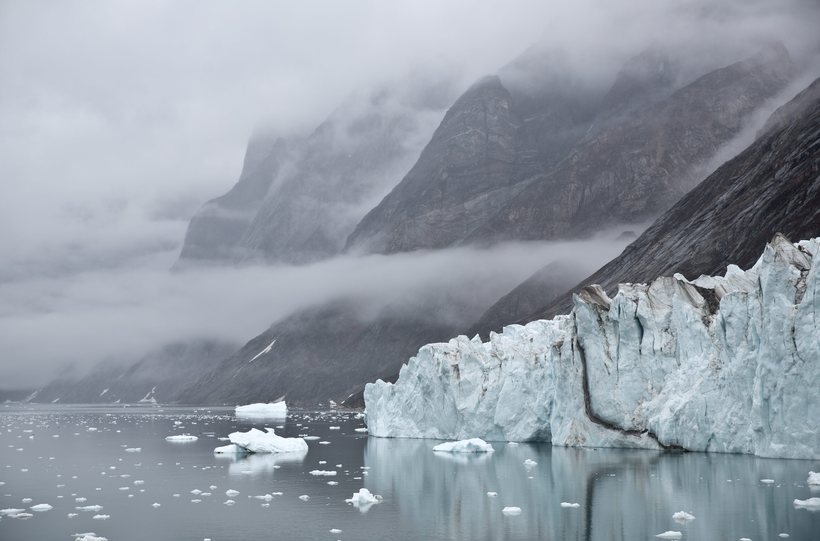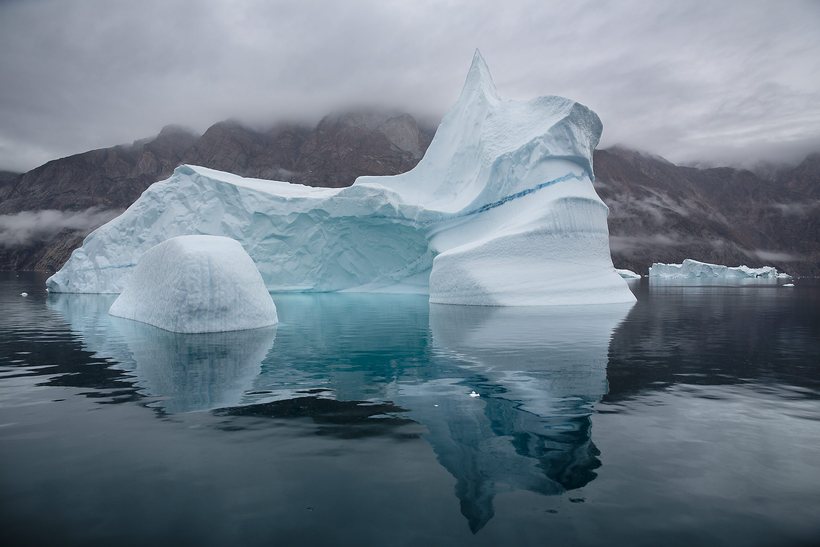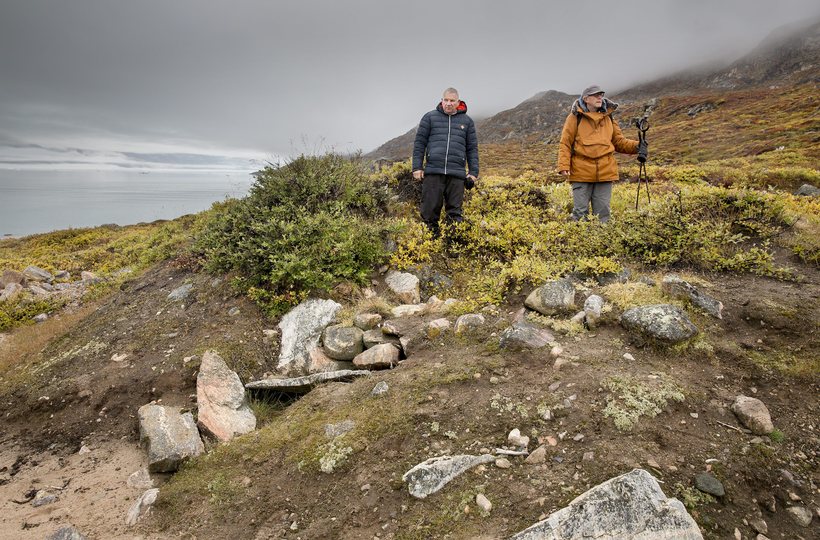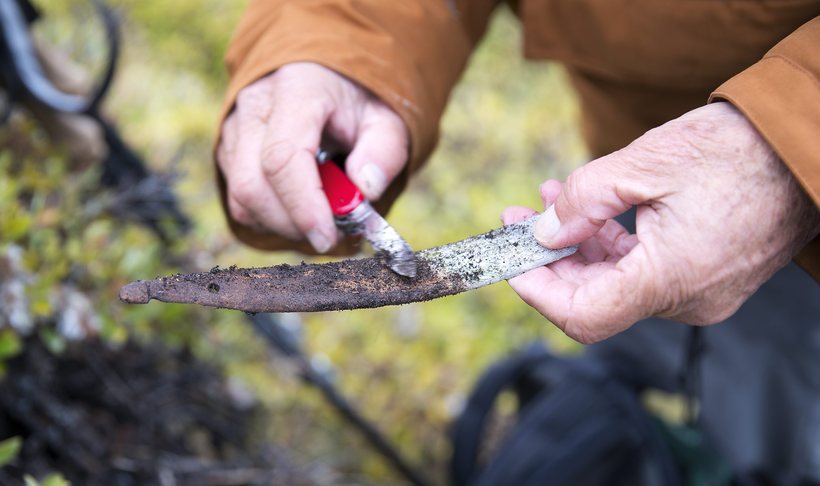Footprints of the ages
Members of the expedition sail on the boat Hildur into Scoresby Sound, the longest fjord system in the world: Heiðar Guðjónsson, Óskar Þór Axelsson, Haraldur Sigurðsson, Áki Ásgeirsson, Hörður Sigurbjarnarson, Júlíus Kemp and Tómas Örn Tómasson. Rax / Ragnar Axelsson
The fog slithers along the surface of the ocean, where white titans of ice drift in the 1,000 yard deep fjord. Mountaintops reach high into the sky above the oaken sailboat Hildur as she sails between the icebergs on the narrow fjord. Captain Hörður Sigurbjarnarson exudes confidence as he navigates between the icebergs and keeps an eye on each and every one. Some of the smaller ones barely break the surface; ramming into them is not advisable.
The mountaintops reach 6,500 feet. Now and again the fog lifts momentarily, exposing the tops, only to engulf them anew. Those ragged edges are a few hundred million years old. The sides of the mountains are like a layered cake where the fog draws white horizontal lines into the walls that disappear almost vertically into the ocean waves. A rumble can be heard out of the fog as a gigantic iceberg capsizes. Only one tenth of the iceberg is above water as it rumbles in a loud voice in the middle of the fjord.
The iceberg tumbles back and forth for a while, as if observing us, then calms down and the rumbling stops. Small floes of ice float away from it. They must have broken away from one side of the iceberg, altering its balance. These white giants are like living sculptures in one of the most beautiful galleries on Earth. The icebergs are different in size and incredibly majestic, some the azure colour of the sky. If you release your imagination, all kinds of fantastical creatures can be discerned in the ice, as if under a spell, staring out of the frozen walls.
Climatological depository
The oceans store 97.4% of all water on Earth. Fresh water is about 2.6% of the Earth’s water. 2.1% of the Earth’s water is stored by the world’s glaciers, 80% of the fresh water. They are therefore Earth’s largest depository of fresh water. The icebergs floating on the fjord are snow that fell on the glacier a thousand years ago, but are now rapidly melting into the unceasing circulation of the ocean’s currents.
Water, more than any other phenomenon, holds the key to life. The glaciers preserve the footprints of our climate through the ages, volcanic activity and life on Earth going back hundreds of thousands of years. Water is like a community that traverses the globe via ocean currents, rivers and lakes.
The icebergs floating in the ocean are magnificent to behold, but it takes effort not to entertain the jarring thought that sometime in the future, icebergs and glaciers will be a thing of the past and only exist in pictures. That is one consequence of global warming.
These white giants, as magnificent as they are, can be extremely dangerous. When big chunks of ice break off, they can create huge waves that wreak havoc as they hit land. When a large iceberg capsizes, it is dangerous to be nearby. Hunters in small boats have disappeared when icebergs capsized over them, some never to be found. Such events do not whip the world press into a frenzy; what happens in the Arctic rarely makes world headlines.
We set out, a few friends from Iceland and the United States, to get a closer look at the all but untouched world of wonders in Greenland. The purpose is to explore, learn and film the wonders of the land and its people and make a documentary about the North, its past and future. A 300 feet high iceberg, decidedly higher than Reykjavík’s Hallgrímskirkja, with a giant hole in the middle, draws our attention. We sail alongside it and look in awe at its beauty; this majestic iceberg has few equals in the fjord.
The hole in the middle was probably created by a vortex that formed as the melting water coursed like a river along the glacier and dug a hole into it. Now this thousand year old clump of ice has broken off the ice cap that covers Greenland and fallen into the sea, where it will float and eventually melt away. There is something special about this iceberg; it appears strong and solid, although you can never rely on superficial characteristics. Other icebergs in the vicinity do not seem as reliable. They are more porous and look as if they could break at any moment. Having examined the iceberg closely, we decide to set foot on it and climb into the hole. We sail over light blue submerged ice and land at an edge above water.
Members of the expedition enter the glacier which creeps into Scoresby Sound, where icebergs fall into the sea. Photo/Rax
Under the watchful eyes of fantastical creatures
It is extraordinary to gaze into the light blue ice just beneath our Zodiac. Most of the iceberg is submerged, and we are sailing over that part. This entails some risk. Heiðar Guðjónsson and Hans Humes jump onto the slippery ice and walk on cleats towards the hole. The rest of us row on the Zodiac around the iceberg and shoot pictures of them as they stand in the hole. They are dwarfed by the iceberg; the proportions are striking. It is improbable that it will capsize or break while we are next to it.
It is as if fantastical creatures are keeping an eye on the two friends as they amble about their habitat. Half a face in profile on the right side of the hole seems to watch and smell them as its nose extends towards them. Only the upper half of the face rises above the ice. It takes nerves of steel to stand on a floating iceberg, and it is not wise to stay long, even though this iceberg appears more solid than the others.
There is a certain relief as we sail away from the iceberg with our two friends back on board, feeling a little as if they just set foot on the moon. Heiðar and Hans have had many encounters with the forces of nature, climbed the peaks and skied the highest mountains of Greenland in temperatures of 40 °C below zero. Yet now they are climbing an iceberg for the first time. One should not make a habit of standing on icebergs, but the world needs to be exposed to the magnificence of the Arctic and sense the smallness of man in nature, in this case rapidly melting giant icebergs.
Nothing in life is entirely devoid of danger and sometimes one must go beyond the ordinary to make people aware and get them to think about the state of world. It always takes an effort to reach a goal, on any stage of life.
Sigurður Friðriksson and Haraldur Sigurðsson examine remains and traces left by Inuit people in Scoresby Sound, possibly dating back to the 15th century. Rax / Ragnar Axelsson
A threat to the world
The north is the scene of events far removed from the routine life of big cities, but could be fateful for man‘s future on Earth. The world is threatened when the ice melts and the oceans rise. There will also be opportunities when shipping lanes in the Arctic open up. Sea levels will change if the glaciers continue to melt. The coastline of Greenland will lengthen, as will Iceland‘s, because Greenland‘s ice cap acts like a magnet on the ocean, drawing it in with a reach of up to 380 nautical miles from its shores.
In other places the sea levels will rise and some countries, such as the Maldives, might simply be submerged. Most of us have families, children and grandchildren. Could future difficulties for them be averted with the right decisions today? Is there someone who does not love their children and grandchildren? Are we willing to take it for granted that there is no cause for alarm when 97% of the scientific community beg to differ? Are world leaders willing to leave the fight to future generations, when it might be too late to make a difference?
The temperatures of the Earth have risen and fallen due to natural causes. All this has happened before in some way. The Milankovitch cycles, which show the cyclical progression of the Earth’s climate through hundreds and thousands of years, now for the first time have the carbon dioxide curve ahead of the temperature curve. As a rule the Earth’s climate heats up, and the carbon dioxide levels rise as a result. This has now been reversed, a measurement of too much man-made pollution.
The Earth’s population has now exceeded seven billion and will reach ten billion in a few years. That is a lot of mouths to feed, and doing so will inevitably increase pollution. Everyone involved in these matters must do some serious thinking and make decisions in the interests of all mankind, also those who think that everything will take care of itself and nothing is wrong.
They all have enormous responsibility, as the scientists agree that time is short. Never before have the levels of carbon dioxide in the atmosphere been this high, and big holes are appearing in the Siberian tundra, releasing methane far more dangerous than carbon dioxide into the atmosphere. Volcanic eruptions have their role to play. How do they influence the world’s climate? Whatever one’s opinion on global warming and climate change, everyone must realise that the Earth has to enjoy the benefit of the doubt, since there are no second chances. We have no other home.
Technology takes over
There is a difference of opinion on how or whether to exploit the resources of the Arctic and Greenland. The Greenlanders want to build a new Greenland and make use of the opportunities they have. The hunter community as it was preserved for centuries is now on the wane. The heritage of the hunter community in Greenland is important, but everything changes. The hunters view what‘s in store with stoic calm; when the ice will become too thin to hunt the way they have done for four thousand years. Technology takes over, bringing new opportunities.
The group sailing on Scoresby Sound and around Milne Land is strong and experienced. The men know what dangers lurk from their own travels around the world and the wilderness of Greenland in all seasons. This diverse group from different walks of life, business, science, economics, investment, film production and direction, photography, seamanship, tourism and other branches, is a perfect mix for this adventure, and you could do worse with the crew. There are no problems on board this vessel. We do what we want to do. A daily swim in the 1°C to 2°C ice cold waters toughens you and pulls the group together.
We plunge into the sea, one after the other, and swim for a while. It is as if the body wakes up, and after the swim it feels as if an extra burst of energy is released. Everyone is alert, on lookout for each other, should something happen while we swim. Safety comes first, and no one stays too long in the water because of the cold. As always in life, opinions differ. It is good to listen to opinions that broaden the horizon, and expand the knowledge of all on board.
It is not bad to get presentations on board the boat from some of the most capable experts in the world about geology and Greenland’s history billions of years back in time, switching into economics and finance and the opportunities ahead. We debate the turn of events in the Arctic and ponder the results of global warming and the opportunities that inevitably will rise as the Greenland’s icecap and the polar ice melt.
The days fly by. Everyone on board experiences something new in this wondrous world of Greenland. The morning workout comes when the anchor is lifted by towing a chain from up to 200 feet, depending on the depth where we stop. Some jest that they arose before the others to chase away the polar bears so everybody would be safe on deck.
Beautiful polar bears
“Safety must come first,” says movie producer Ingvar Þórðarson with a grin. “The bears I drove away were really beautiful. One of them was especially big; I did not dare show him to you.”
Groggy shipmates at first cannot quite make out whether there really were polar bears about, but then they realize. But who objects to a little prank? They only add colour to the days.
Porridge and cod liver oil for breakfast! Robert the cook is up and about before the rest of us and everything is set. So it is throughout the journey.
We examine the geology of Red Island and other places. There are interesting dikes similar to those being formed underground in the current eruption in Iceland. Haraldur Sigurðsson, professor of geology and volcanology, is in his element and uses his hammer relentlessly to chip away rocks and see what story they tell.
A glacier tongue reaches into the ocean, above it towers a steep wall of ice, which can fall into the sea at any moment. In some places in the sides of the mountains there are crevices and ravines where the glacier has receded. Small pebbles jettison down the steep glacier, on the shore it has pushed the rocks forward, creating a wave formation. One has to watch out for lose rocks careening down at full speed. Óskar, Heiðar, and Hans climb the glacier, which is full of cracks and crevices. Above them the fog approaches along the mountainside above them and they seem tiny as they walk about on the glacier.
Inside the fjord we stumble upon the remnants of an Inuit settlement and by coincidence find the ruins of a home barely recognizable. Haraldur Sigurðsson and captain Hörður Sigurbjarnarson decide to cast anchor where Haraldur thinks Inuit might have settled centuries ago. He is used to finding old ruins and settlements on volcanic islands. We go ashore to search; Haraldur walks around exploring the shoreline and the roots of the mountain while Ingvar Þórðarson lifts his rifle, ready to defend the group should polar bears approach. Ingvar has been around and nothing escapes him. He has the eyes of a hunter.
Isn‘t that a house?
“Isn‘t that a house?” shouts captain Diddi, a prolific fisherman for many years, and points at a grassy outline with a stone construction. It is not easy to spot the ruin, which had fallen and become a part of the landscape. It looks like no one has been here or realized that here lie the remnants of human habitation. A rotting and weathered bone with a hole in it juts out where once there was a wall, perhaps from a kayak. We carefully remove the bone for age analysis. The rest we leave, for this is definitely a site for archaeologists.
Inuit people are believed to have arrived here more than a thousand years ago. Could the ruins be that old? The analysis will answer that question.
More likely these are ruins of a house constructed from stones from the period before the little ice age that started around 1400. Perhaps the river swept away a part of a little village or a group of houses when it burst forth during the spring thaw. The house is just by the river where it enters the sea. The view from the hut must have been beautiful; a mountain hall towers over the fjord and the hunting grounds of the Inuit. No one knows what happened to the people but most likely this is where they passed away.
It seems clear that not many would have come ashore in this place. Elsewhere in the fjord there is sediment from the Jurassic geologic period. We find fossils over 150 million years old. There is excitement in the air. Will we find footprints from dinosaurs that walked upon these grounds 150 million years ago? Footprints have been discovered next to the Constable Point Airport. We find no signs of dinosaurs on this journey, but in the rocks there are fossilized conches, over 150 million years old.
It did not take Haraldur long to find the fossils. It seems to be his specialty to find something no one else sees, such as a village that disappeared in the eruption on Tambora. Haraldur has had a distinguished career as a scientist, and has often been in tight situations that bring Indiana Jones to mind. Exploring Haiti, Haraldur and his assistants, Steve Carey and Steve D‘Hondt, were looking at 65 million year old sediments when men with machetes started following them, full of suspicions about their intentions as scientists.
Glass pearls were found in the sediments in Haiti, the only ones preserved on Earth, which upon analysis divulged how the dinosaurs and the bulk of life on Earth was exterminated. The pearls hailed from the massive explosion that occurred when a meteor, five miles in diameter, hit the Yucatan Peninsula in Mexico, probably the most unfortunate place it could have landed on Earth. Had the meteor fallen into the sea, dinosaurs would probably still rule the Earth. For years after the impact, darkness and bitter cold reigned on Earth, and new animal species were born. It is apt that a volcano on Io, one of the moons of Jupiter, was named in Haraldur‘s honour. Should Haraldur and Indiana Jones pass each other in the street, it is not unlikely that the latter would take his hat off to the former!
It is with some regret that we sail out of the fjord, this amazing world of wilderness, almost unique on Earth. Ittoqqortoormiit is a small village at the mouth of the fjord where everybody in the area lives, some 400 people. It is one of the most remote villages in Greenland. The nearest village is in Iceland. It is impossible to tell where its future lies; some want to move everyone away, but the villagers want to stay. They tell us there is hardly anyone left aged 30 to 50.
A woman rescued from a burning house
An alarm sounds and a four-wheeler comes racing along the road. It is the fire department. A house is on fire. A woman is rescued through a window on the roof. The villagers rush to watch the firemen put out the fire. They lead the woman, covered with black soot, away. The fire was probably caused by a burning cigarette.
Kap Hope is a small, abandoned village. No one lives there anymore. A skull from a musk ox is like a symbol for desolation. Some of the dilapidated houses are on the verge of collapse. In the sand on the beach there are footprints from a polar bear. A boat is half-buried in the sand, wrecked by the waves.
We alight in the village in the Zodiac, which fills with water in the surf. Some fall into the sea. Everybody is soaking wet, yet we walk around the village to look around. It is depressing to see the village going to seed.
The weather is getting worse. The autumn lows are beginning to make themselves felt and the wind wails. Winter is drawing near. Eight men in a small rubber boat sail away from the abandoned village onto the open sea where the sailboat awaits. The boat is silent as it bounces off the waves; everyone is lost in their own thoughts.
None of us will forget this amazing trip. We covered a lot of ground in one week as we sailed in one of the most magnificent fjords on Earth. As we depart we observe the giant icebergs floating where the fjord opens to the sea. Soon they will be stuck as ice forms on the fjords. The view changes every year with new icebergs. They get to survive over winter, and then they will melt as spring returns.















